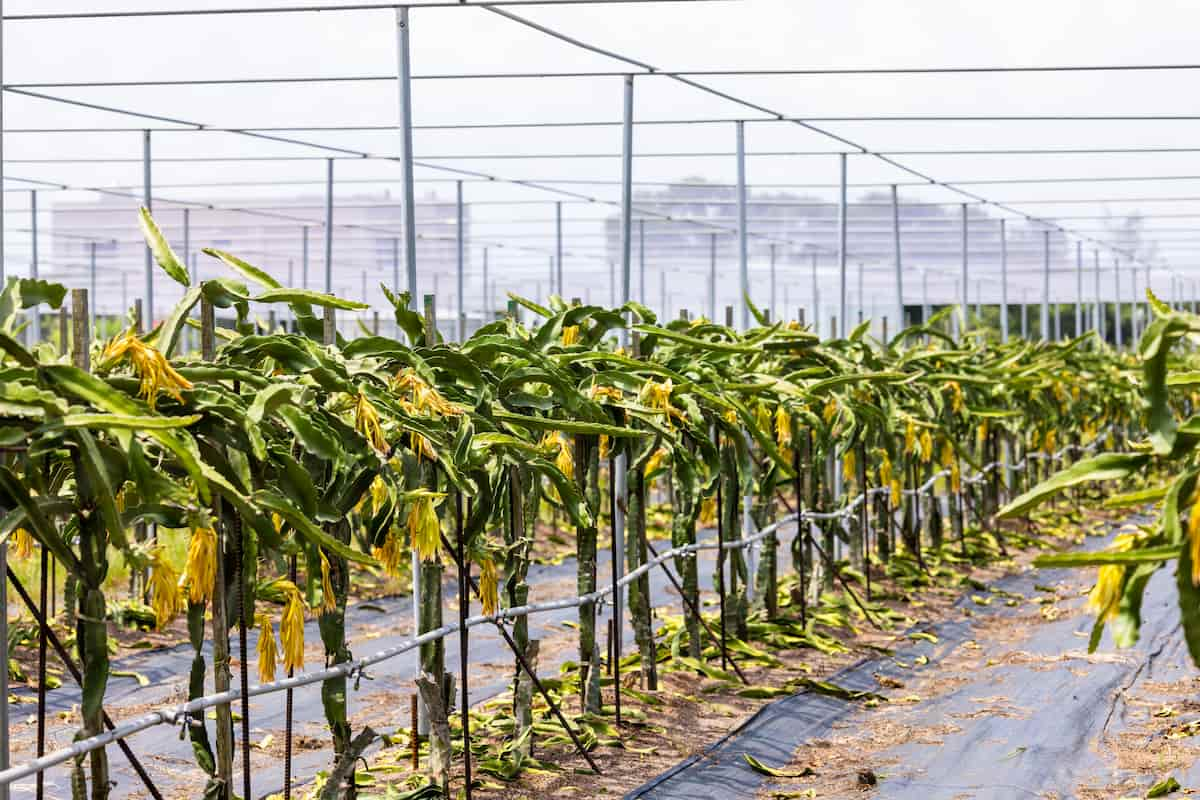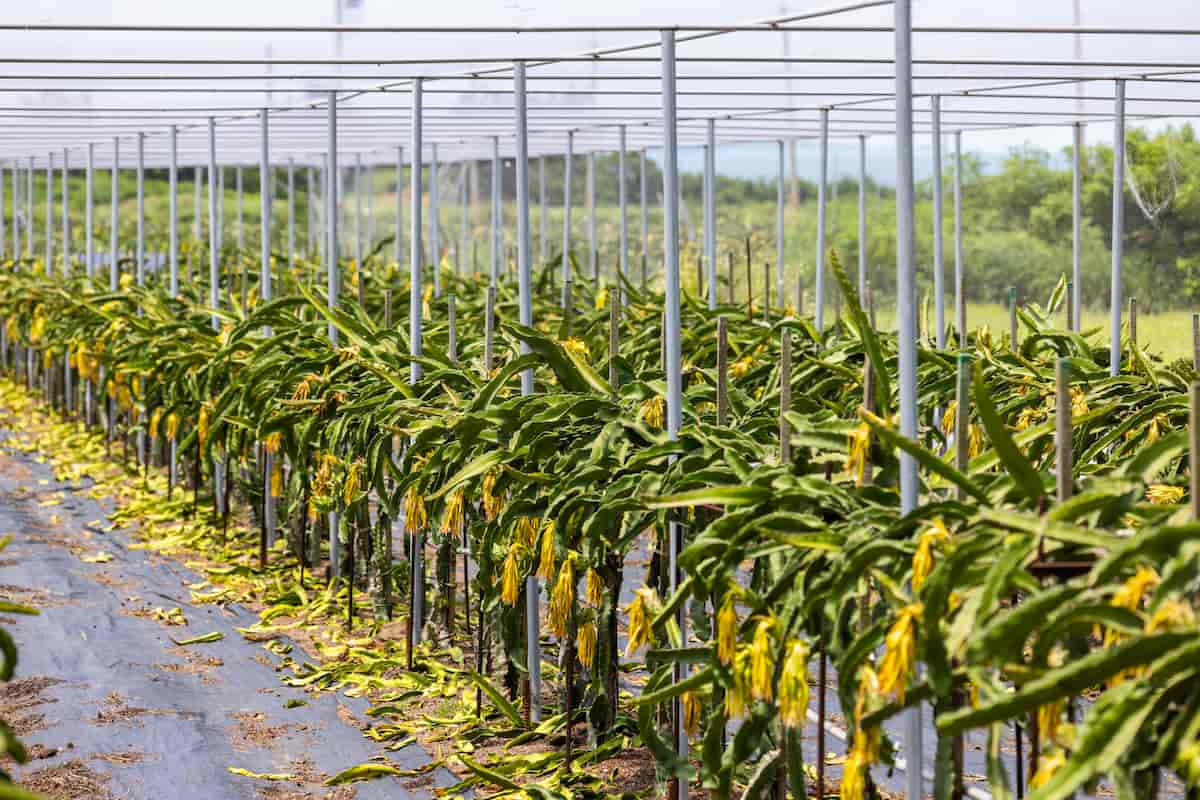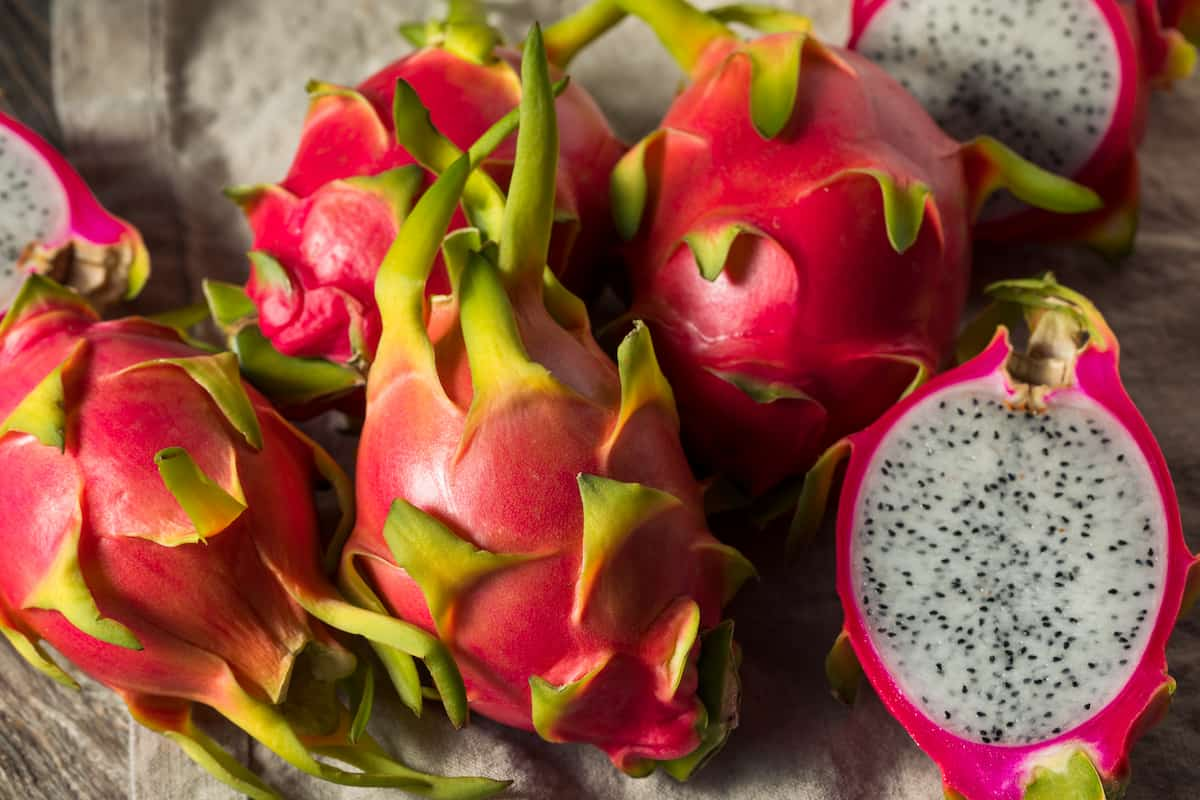Pitayas and dragonfruit are the names given to large, edible fruits that grow on various tropical cacti. As they climb trees, these cacti can reach impressive heights as they grow 30 feet tall or more, attaching themselves with aerial roots as they grow. Plants of the dragon fruit species grow sprawling and branching in addition to climbing. You can grow dragon fruit in a greenhouse with the right techniques and know-how.

How to Grow Dragon Fruit in a Greenhouse
Soil for Growing Dragon Fruit Plants in Greenhouse
Planting dragon fruit requires a well-draining growing medium that contains a lot of organic matter, but there are two musts when choosing a growing medium. A pH of 6.0 to 7.0 is also ideal for cacti and succulents. Using a pre-mixed potting medium that contains compost is a good option for cacti and succulents.
Sunlight Requirements for Growing Dragon Fruit Plants in Greenhouse
Dragon fruit plants can grow in full sun to part sun, with some cultivars more tolerant of direct sunlight than others. Imagine gardening in a hot climate where the temperature regularly exceeds this plant’s preferred maximum temperature of 27°C. Your plant may need to be placed in part shade in that case but double-check the sun tolerance of the cultivar.
Suitable Types and Varieties of Dragon Fruit to Grow in Greenhouse
Dragon fruit varieties vary in color, flavor, and production. If you are planning on providing certain conditions, it is best to research which variety will work best for them.
- Hylocereus undatus (Pitaya blanca) is most commonly grown in commercial fruit production settings. The fruit is bright pink with white flesh.
- Hylocereus costaricensis has bright pink to red fruit and matching flesh.
- Hylocereus megalanthus produces yellow and white fruit.
- The fruit of Hylocereus guatemalensis is deep pink with pink spines and bright purple flesh.
- The flesh and skin of Hylocereus polyrhizus are beet-red
- Hylocereus stenopterus is a rare variety that produces fleshy green fruits
Growing Dragon Fruit Plants from Seeds
- Dragon fruit seeds can be harvested directly from the fruit. A single fruit can yield hundreds of plants, which is easy and cost-effective.
- Take the flesh and seeds out of a dragon fruit by cutting it in half.
- Put the flesh and seeds in a sieve and run them under the tap to separate them.
- Plant the seeds in deep trays or pots and cover them with potting compost.
- When they are a few inches tall, transfer them to individual pots, being careful not to damage the roots. You can use a cocktail stick or the tip of a pencil to tease out the roots.
- As the plants grow, bigger pots will also be needed. Large, deep pots are ideal for growing dragon fruit plants. Therefore, they can remain in the same pot for several years.
In case you missed it: How to Grow Stevia in Greenhouse: A Step-By-Step Guide for Seed to Harvest

Growing Dragon Fruit Plants From Cuttings
- Plants can be grown from cuttings of dragon fruit. When grown from cuttings, dragon fruit will crop faster than from seed. Dragon fruit cuttings should be planted as follows:
- From a mature plant, cut a branch 4 to 5 inches long. You can take several cuttings from one branch, either from the tip or the middle.
- Ensure that your cutting is kept somewhere warm and dry for at least four to seven days to ensure the fungal infection does not occur.
- Put your cutting upright into well-drained potting soil and add some sand or grit if necessary to improve drainage.
- Ensure the substrate is moist but not damp by watering it every 2 to 4 weeks.
Watering Requirements for Growing Dragon Fruit in Greenhouse
Watering your dragon fruit too much is the fastest way to kill it. So only water the plant when the top 1/3-1/2 of the soil is dry but not wilting. The plant will be stressed and produce fewer flowers or fruits if it is allowed to wilt. If your plants climb on poles, you can water them with a drip line or a mister from above. Attach a drip line to the container’s center support to achieve this. Ensure the drip nozzle is on top of the support line and runs down the pole as it drips. Watering your dragon fruit this way is the best way to keep it happy and healthy.
Fertilizing Requirements for Growing Dragon Fruit Plants
Cacti require little maintenance. Their feeding habits are not heavy, and they do not require a lot of fertilizer. Your plant will suffer if you over-fertilize it. Apply an organic, low-nitrogen fertilizer at planting and even less in the winter every other month. Cow manure is a popular fertilizer among professional dragon fruit growers. You should use only aged or composted manure rather than fresh stuff since fresh manure can contain an overabundance of nitrogen.
Mulching for Dragon Fruit Plants Growing in Greenhouse
It is also a good idea to mulch around dragon fruit plants. As a result, less irrigation water is needed since weed growth is suppressed and water evaporation is prevented. Leave an unmulched circle around dragon fruit plants’ stems about eight inches wide when mulching. It will prevent overly moist conditions, which could cause rotting.
Staking and Trellising Dragon Fruit Plants
The plants are climbers, which means they require something to climb on. Since they produce dense foliage and heavy dragon fruit, you will need a sturdy trellis system if you plan on growing them for fruit and not simply as a whimsical act of pure fun. When growing dragon fruits, you can choose from a variety of setups. Professional Dragon fruit growers often use a four-by-four wood or cement post reinforced with rebar.
When To Prune Dragon Fruit Plant
Dragon fruit plants are usually pruned in the fall or as needed to maintain their desired size. If overcrowded, the plant will become infested with pests, fungi, and diseases. Besides needing more maintenance (watering and fertilizer), crowded plants produce less fruit. In fact, pruning the plant stimulates flowering and new growth, so it is a good thing to do.
Harvesting Dragon Fruits
Fruit is ripe approximately one month after flowering but can vary depending on local conditions. Once picked, the fruit will not ripen, so look for other signs before picking. Make sure that the color of the fruit is bright and even all over and that the small “wings” are beginning to wither. Simply press the fruit in your hand; if it’s ripe, it will give a little bit. You can pick fruit by twisting it off the plant or cutting it with secateurs. Seeds are edible, but the skin is not.
In case you missed it: How to Grow Cloves in a Greenhouse: A Step-by-Step Guide for Seed to Harvest

Conclusion
Several vegetable farmers are now using greenhouses to grow fruits. Despite being in the north, vegetable farmers will grow dragon fruit indoors. You should always know the risks involved as a greenhouse grower. You can grow dragon fruit indoors but must decide the planting direction according to the local market.
- Feed Your Flock for Less: Top 10 Tips to Save on Chicken Feed
- Ultimate Guide to Ossabaw Island Hog: Breeding, Raising, Diet, and Care
- Hatching Answers: The Top 10 Reasons Your Chickens Aren’t Laying Eggs
- Eggs and Economics: Breaking Down the Cost of Raising Backyard Chickens
- Defend Your Greens: Proven Methods to Keep Iguanas Out of Your Garden
- Ultimate Guide to Cinnamon Queen Chicken: A Comprehensive Guide for Beginners
- Ultimate Guide to California Tan Chicken: Breeding, Raising, Diet, Egg-Production and Care
- Ultimate Guide to Marsh Daisy Chicken: Breeding, Raising, Diet, and Care
- 10 Types of Chicken Farming Businesses You Can Start for Profits